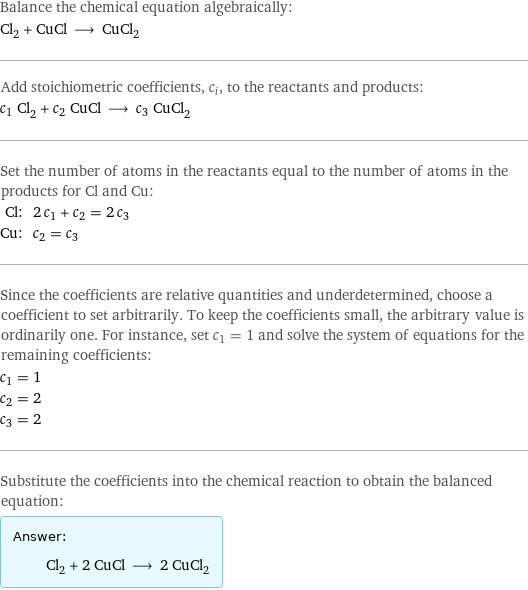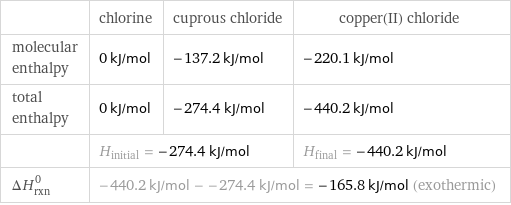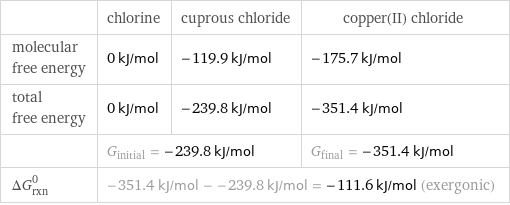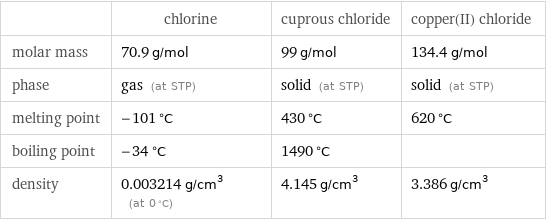Input interpretation

Cl_2 chlorine + CuCl cuprous chloride ⟶ CuCl_2 copper(II) chloride
Balanced equation

Balance the chemical equation algebraically: Cl_2 + CuCl ⟶ CuCl_2 Add stoichiometric coefficients, c_i, to the reactants and products: c_1 Cl_2 + c_2 CuCl ⟶ c_3 CuCl_2 Set the number of atoms in the reactants equal to the number of atoms in the products for Cl and Cu: Cl: | 2 c_1 + c_2 = 2 c_3 Cu: | c_2 = c_3 Since the coefficients are relative quantities and underdetermined, choose a coefficient to set arbitrarily. To keep the coefficients small, the arbitrary value is ordinarily one. For instance, set c_1 = 1 and solve the system of equations for the remaining coefficients: c_1 = 1 c_2 = 2 c_3 = 2 Substitute the coefficients into the chemical reaction to obtain the balanced equation: Answer: | | Cl_2 + 2 CuCl ⟶ 2 CuCl_2
Structures

+ ⟶
Names

chlorine + cuprous chloride ⟶ copper(II) chloride
Reaction thermodynamics
Enthalpy

| chlorine | cuprous chloride | copper(II) chloride molecular enthalpy | 0 kJ/mol | -137.2 kJ/mol | -220.1 kJ/mol total enthalpy | 0 kJ/mol | -274.4 kJ/mol | -440.2 kJ/mol | H_initial = -274.4 kJ/mol | | H_final = -440.2 kJ/mol ΔH_rxn^0 | -440.2 kJ/mol - -274.4 kJ/mol = -165.8 kJ/mol (exothermic) | |
Gibbs free energy

| chlorine | cuprous chloride | copper(II) chloride molecular free energy | 0 kJ/mol | -119.9 kJ/mol | -175.7 kJ/mol total free energy | 0 kJ/mol | -239.8 kJ/mol | -351.4 kJ/mol | G_initial = -239.8 kJ/mol | | G_final = -351.4 kJ/mol ΔG_rxn^0 | -351.4 kJ/mol - -239.8 kJ/mol = -111.6 kJ/mol (exergonic) | |
Equilibrium constant
![Construct the equilibrium constant, K, expression for: Cl_2 + CuCl ⟶ CuCl_2 Plan: • Balance the chemical equation. • Determine the stoichiometric numbers. • Assemble the activity expression for each chemical species. • Use the activity expressions to build the equilibrium constant expression. Write the balanced chemical equation: Cl_2 + 2 CuCl ⟶ 2 CuCl_2 Assign stoichiometric numbers, ν_i, using the stoichiometric coefficients, c_i, from the balanced chemical equation in the following manner: ν_i = -c_i for reactants and ν_i = c_i for products: chemical species | c_i | ν_i Cl_2 | 1 | -1 CuCl | 2 | -2 CuCl_2 | 2 | 2 Assemble the activity expressions accounting for the state of matter and ν_i: chemical species | c_i | ν_i | activity expression Cl_2 | 1 | -1 | ([Cl2])^(-1) CuCl | 2 | -2 | ([CuCl])^(-2) CuCl_2 | 2 | 2 | ([CuCl2])^2 The equilibrium constant symbol in the concentration basis is: K_c Mulitply the activity expressions to arrive at the K_c expression: Answer: | | K_c = ([Cl2])^(-1) ([CuCl])^(-2) ([CuCl2])^2 = ([CuCl2])^2/([Cl2] ([CuCl])^2)](../image_source/024a4dc52e83f4ad8b2005a636e07163.png)
Construct the equilibrium constant, K, expression for: Cl_2 + CuCl ⟶ CuCl_2 Plan: • Balance the chemical equation. • Determine the stoichiometric numbers. • Assemble the activity expression for each chemical species. • Use the activity expressions to build the equilibrium constant expression. Write the balanced chemical equation: Cl_2 + 2 CuCl ⟶ 2 CuCl_2 Assign stoichiometric numbers, ν_i, using the stoichiometric coefficients, c_i, from the balanced chemical equation in the following manner: ν_i = -c_i for reactants and ν_i = c_i for products: chemical species | c_i | ν_i Cl_2 | 1 | -1 CuCl | 2 | -2 CuCl_2 | 2 | 2 Assemble the activity expressions accounting for the state of matter and ν_i: chemical species | c_i | ν_i | activity expression Cl_2 | 1 | -1 | ([Cl2])^(-1) CuCl | 2 | -2 | ([CuCl])^(-2) CuCl_2 | 2 | 2 | ([CuCl2])^2 The equilibrium constant symbol in the concentration basis is: K_c Mulitply the activity expressions to arrive at the K_c expression: Answer: | | K_c = ([Cl2])^(-1) ([CuCl])^(-2) ([CuCl2])^2 = ([CuCl2])^2/([Cl2] ([CuCl])^2)
Rate of reaction
![Construct the rate of reaction expression for: Cl_2 + CuCl ⟶ CuCl_2 Plan: • Balance the chemical equation. • Determine the stoichiometric numbers. • Assemble the rate term for each chemical species. • Write the rate of reaction expression. Write the balanced chemical equation: Cl_2 + 2 CuCl ⟶ 2 CuCl_2 Assign stoichiometric numbers, ν_i, using the stoichiometric coefficients, c_i, from the balanced chemical equation in the following manner: ν_i = -c_i for reactants and ν_i = c_i for products: chemical species | c_i | ν_i Cl_2 | 1 | -1 CuCl | 2 | -2 CuCl_2 | 2 | 2 The rate term for each chemical species, B_i, is 1/ν_i(Δ[B_i])/(Δt) where [B_i] is the amount concentration and t is time: chemical species | c_i | ν_i | rate term Cl_2 | 1 | -1 | -(Δ[Cl2])/(Δt) CuCl | 2 | -2 | -1/2 (Δ[CuCl])/(Δt) CuCl_2 | 2 | 2 | 1/2 (Δ[CuCl2])/(Δt) (for infinitesimal rate of change, replace Δ with d) Set the rate terms equal to each other to arrive at the rate expression: Answer: | | rate = -(Δ[Cl2])/(Δt) = -1/2 (Δ[CuCl])/(Δt) = 1/2 (Δ[CuCl2])/(Δt) (assuming constant volume and no accumulation of intermediates or side products)](../image_source/50ce5d8923ab7b06faf315e34ba84359.png)
Construct the rate of reaction expression for: Cl_2 + CuCl ⟶ CuCl_2 Plan: • Balance the chemical equation. • Determine the stoichiometric numbers. • Assemble the rate term for each chemical species. • Write the rate of reaction expression. Write the balanced chemical equation: Cl_2 + 2 CuCl ⟶ 2 CuCl_2 Assign stoichiometric numbers, ν_i, using the stoichiometric coefficients, c_i, from the balanced chemical equation in the following manner: ν_i = -c_i for reactants and ν_i = c_i for products: chemical species | c_i | ν_i Cl_2 | 1 | -1 CuCl | 2 | -2 CuCl_2 | 2 | 2 The rate term for each chemical species, B_i, is 1/ν_i(Δ[B_i])/(Δt) where [B_i] is the amount concentration and t is time: chemical species | c_i | ν_i | rate term Cl_2 | 1 | -1 | -(Δ[Cl2])/(Δt) CuCl | 2 | -2 | -1/2 (Δ[CuCl])/(Δt) CuCl_2 | 2 | 2 | 1/2 (Δ[CuCl2])/(Δt) (for infinitesimal rate of change, replace Δ with d) Set the rate terms equal to each other to arrive at the rate expression: Answer: | | rate = -(Δ[Cl2])/(Δt) = -1/2 (Δ[CuCl])/(Δt) = 1/2 (Δ[CuCl2])/(Δt) (assuming constant volume and no accumulation of intermediates or side products)
Chemical names and formulas

| chlorine | cuprous chloride | copper(II) chloride formula | Cl_2 | CuCl | CuCl_2 Hill formula | Cl_2 | ClCu | Cl_2Cu name | chlorine | cuprous chloride | copper(II) chloride IUPAC name | molecular chlorine | | dichlorocopper
Substance properties

| chlorine | cuprous chloride | copper(II) chloride molar mass | 70.9 g/mol | 99 g/mol | 134.4 g/mol phase | gas (at STP) | solid (at STP) | solid (at STP) melting point | -101 °C | 430 °C | 620 °C boiling point | -34 °C | 1490 °C | density | 0.003214 g/cm^3 (at 0 °C) | 4.145 g/cm^3 | 3.386 g/cm^3
Units
